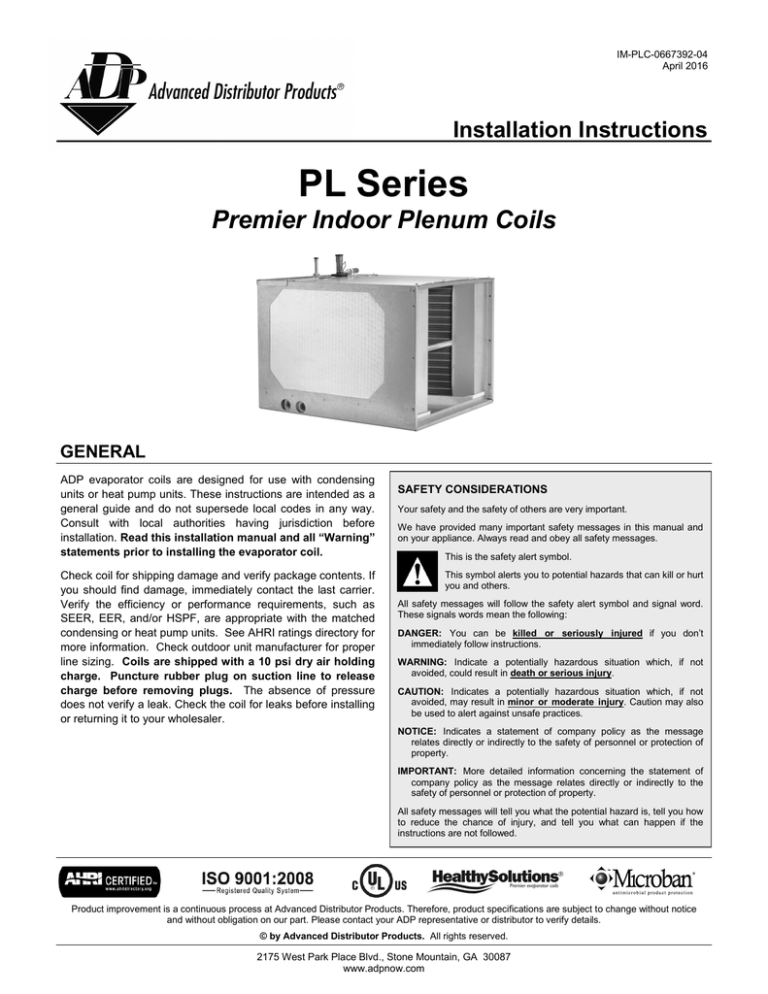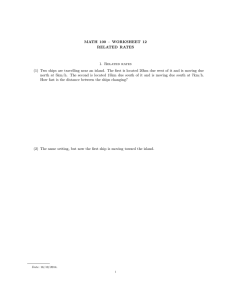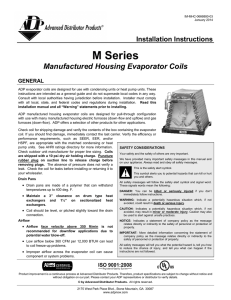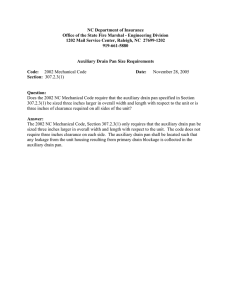
IM-PLC-0667392-04
April 2016
Installation Instructions
PL Series
Premier Indoor Plenum Coils
GENERAL
ADP evaporator coils are designed for use with condensing
units or heat pump units. These instructions are intended as a
general guide and do not supersede local codes in any way.
Consult with local authorities having jurisdiction before
installation. Read this installation manual and all “Warning”
statements prior to installing the evaporator coil.
Check coil for shipping damage and verify package contents. If
you should find damage, immediately contact the last carrier.
Verify the efficiency or performance requirements, such as
SEER, EER, and/or HSPF, are appropriate with the matched
condensing or heat pump units. See AHRI ratings directory for
more information. Check outdoor unit manufacturer for proper
line sizing. Coils are shipped with a 10 psi dry air holding
charge. Puncture rubber plug on suction line to release
charge before removing plugs. The absence of pressure
does not verify a leak. Check the coil for leaks before installing
or returning it to your wholesaler.
SAFETY CONSIDERATIONS
Your safety and the safety of others are very important.
We have provided many important safety messages in this manual and
on your appliance. Always read and obey all safety messages.
This is the safety alert symbol.
This symbol alerts you to potential hazards that can kill or hurt
you and others.
All safety messages will follow the safety alert symbol and signal word.
These signals words mean the following:
DANGER: You can be killed or seriously injured if you don’t
immediately follow instructions.
WARNING: Indicate a potentially hazardous situation which, if not
avoided, could result in death or serious injury.
CAUTION: Indicates a potentially hazardous situation which, if not
avoided, may result in minor or moderate injury. Caution may also
be used to alert against unsafe practices.
NOTICE: Indicates a statement of company policy as the message
relates directly or indirectly to the safety of personnel or protection of
property.
IMPORTANT: More detailed information concerning the statement of
company policy as the message relates directly or indirectly to the
safety of personnel or protection of property.
All safety messages will tell you what the potential hazard is, tell you how
to reduce the chance of injury, and tell you what can happen if the
instructions are not followed.
Product improvement is a continuous process at Advanced Distributor Products. Therefore, product specifications are subject to change without notice
and without obligation on our part. Please contact your ADP representative or distributor to verify details.
© by Advanced Distributor Products. All rights reserved.
2175 West Park Place Blvd., Stone Mountain, GA 30087
www.adpnow.com
PLENUM COIL
Drain Pans
IMPORTANT
Drain pans are made of a polymer that can withstand
temperatures up to 450 deg. F.
For proper operation, after brazing, attach and insulate
the TXV sensor bulb at a 10 to 2 o’clock position to the
main suction line no more than one foot from the suction line connection. If necessary, the bulb can be installed on a vertical suction line. In this instance, the
bulb must be placed before any trap, with the bulb’s
capillary tube facing upward.
Maintain a 3" clearance on drum type heat
exchangers
exchangers.
and
1½"
on
sectionalized
heat
Coil should be pitched approximately 1/2" toward the
drain connections.*
Airflow
FIGURE 1
Low airflow below 360 CFM per 12,000 BTUH can lead to
Air Flow Direction for Plenum Coils
coil freeze-up problems.
Improper airflow across the evaporator coil can cause
component or system problems.
Plenum Coils are designed for horizontal applications only.
Proper performance requires that the air flow into the wide part
of the A and out the tip of the A as shown in Figure 1.
WARNING
Airflow
ONLY
This product may contain fiberglass wool insulation.
Glass wool fibers are known to the State of California
to cause cancer. Disturbing insulation during installation, maintenance, or repair may expose you to glass
wool fibers and may cause respiratory, skin or eye
irritation. For further information on risks associated
with fiberglass wool, consult Material Safety Data
Sheet available from OEM.
* Sloping over 5/8" may cause blow off into the
auxiliary drain hole in high static situations.
2
Airflow
ONLY
METERING DEVICE
For optimum performance, the piston should be sized to match
the recommendation from the outdoor unit manufacturer. If the
outdoor unit manufacturer does not recommend a piston size,
refer to the piston size chart below.
Coils are suited for R-22 and R-410A refrigerants and can be
used with or without a TXV. Replacement TXV part numbers
are listed below; see kit instructions for change out or
installation. PL Series coil are shipped with the TXV sensing
bulb uninstalled. For optimum performance, attach and
insulate the bulb at a 10 to 2 o’clock position outside of the
cabinet to the main suction line no more than one foot from the
suction line connection. When changing a system from AC to
heat pump or heat pump to AC, check the current TXV
specifications to determine if a TXV replacement is required. If
the evaporator coil contains a non-bleed TXV and is used
with a condensing unit containing a reciprocating
compressor, a hard start mechanism will be required on
the outdoor unit.
When changing ADP pistons, refer to Figure 2 and use the
following procedure:
Loosen hex nut located on liquid line and separate from
distributor assembly.
Remove the existing piston from inside the distributor
assembly.
Insert the desired piston into the distributor assembly.
Inspect Teflon O-ring and replace if damaged. Ensure
Teflon O-ring is in place.
Re-install hex nut to body and torque to 10 ft-lbs.
IMPORTANT
When changing the metering device, ensure the metering device matches the refrigerant type and capacity of
the condensing unit. Failure to do so will result in poor
performance and possible compressor damage. All
coils must be matched properly as listed in the AHRI
directory.
FIGURE 2
Side View of Piston Orifice
Liquid Line
Hex Nut
Teflon O-Ring Seal
R-22 TXV Part Numbers
18-36 MBTUH Bleed A/C
65540600
42-60 MBTUH Bleed A/C
65540700
18-36 MBTUH Non-Bleed A/C
99167501
42-60 MBTUH Non-Bleed A/C
99167502
18-36 MBTUH Non-Bleed A/C-HP
65616201
42-60 MBTUH Non-Bleed A/C-HP
65616202
ADP Piston
Distributor Assembly
Coil Cabinet
R-410A TXV Part Numbers
Piston Size
18-36 MBTUH Non-Bleed A/C
65026401
42-60 MBTUH Non-Bleed A/C
65026400
18-36 MBTUH Non-Bleed A/C-HP
65616601
42-60 MBTUH Non-Bleed A/C-HP
65616602
18-36 MBTUH Bleed A/C
67304001
1
42-60 MBTUH Bleed A/C
67304002
18-36 MBTUH Bleed A/C-HP
42-60 MBTUH Bleed A/C-HP
R-22
Ton Piston
R-410A
Part Number
Piston
Size
Part Number
41
100000035
41
100000035
1.5
53
100000036
49
100000049
67304101
2
59
100000037
53
100000036
67304102
2.5
67
100000039
59
100000037
3
73
100000041
67
100000039
3.5
80
100000044
73
100000041
4
84
100000045
76
100000042
5
93
100000047
93
100000047
Size
3
FURNACE ATTACHMENT
Align the bottom edges of the coil and furnace—the included
furnace mount bracket (Figure 3) may be attached to the coil
with 2 screws. Attach coil to furnace flanges using sheet metal
screws. Seal according to local codes.
FIGURE 3
Furnace Attachment
Coil Support Options
1. Support from bottom using furnace stands.
2. Attach hanging straps to back end of sheet metal.
Coil should be level or pitched slightly toward drain
connections.
PLENUM CONNECTIONS
Cutting Duct Takeoffs
Options for Duct Takeoffs
Cut exposed duct board surfaces.
1. Existing or field-fabricated plenum—remove entire end
panel and attach to plenum.
Do not cut into sheet metal—coil damage will result.
2. Flex duct connections—cut holes into coil duct board for
duct connections. Use only tab-style takeoffs; adhesivestyle takeoffs may delaminate the duct board facing.
Duct board is 1" thick; do not cut more than ¾" deeper to
prevent coil damage.
Cut carefully with sharp cutting tool to minimize
Balancing Airflow
delaminating the foil lining; ensure there is no exposed
fiberglass in the airstream.
Use the same number and size of takeoffs on the left and
right sides of coil.
Use end takeoffs after the left and right sides are
balanced.
Locate takeoffs as close as possible to the downstream
end of plenum coil.
SECONDARY DRAIN PAN
FIGURE 4
Pan attachment
Align secondary drain pan tab holes with locator
Locator Embossments
for Secondary Pan
embossments on bottom of coil (Figure 4); pan should be
pitched ½" toward drain.
Attach the secondary pan tabs to the upper pilot
holes on the non-drain side of the coil.
Attach the secondary pan tabs to the lower pilot
holes on the drain side to provide the proper pitch .
Attach secondary pan with sheet metal screws.
Route the drain line per local codes.
4
CONDENSATE DRAIN
Coils are equipped with multiple drain connections. Determine
the drain connections to be used and note the difference
between the primary (green) and secondary (red) openings.
Drain plugs are provided for all openings; remove and discard
the appropriate plugs with ½" drive ratchet and verify that
remaining plugs are tight (2.5 ft-lbs). Attach drain line to pan
with ¾" male pipe thread PVC fittings. Hand tight is adequate.
Do not over tighten & do not reduce drain line size!
FIGURE 5
Drain Trap and Vent Tee
Vent in this location (before trap)
is acceptable as long as proper
drainage is achieved
Vent must extend a minimum
of 2" above the drain pan
2" Min.
Drain Pan
Route drain line(s) so they will not be exposed to freezing
temperatures and do not interfere with accessibility to the coil,
air handling system or filter. The drain should be pitched
downward 1" per 10’ with a 2" trap as close to the coil as
possible. If line makes a second trap, or has an extended run
before termination, a vent tee should be installed after the trap
closest to the pan. See Figure 5.
3/4" MPT
Connector
If the coil is located in or above a living space where damage
may result from condensate overflow, a separate ¾" drain
must be provided from the secondary drain connection. Run
this drain to a place in compliance with local installation codes
where it will be noticed when unit is operational. Condensate
flowing from the secondary drain indicates a plugged primary
drain. Prime the trap with water. Test line for leaks. Test water
flow with unit in operation. A secondary drain pan should
also be installed under the unit as specified by most local
building codes.
2" Min.
Vent “T”
2" Min.
FIGURE 6
Drain Nipple
Drain Pan Configuration Options (these do not supersede local codes)
Option
Primary Drain
(Green Plug)
Secondary Drain
(Red Plug)
Secondary Pan Drain
(Black Pan)
1
As shown in Fig 6
Drain to noticeable area per local codes
Route per local codes
2
As shown in Fig 6
Drain into secondary pan using provided drain nipple
(see Figure 6)
Route per local codes
3
As shown in Fig 6
Connect with TEE to the secondary drain pan
Route per local codes
5
REFRIGERANT LINE INSTALLATION
ADP recommends installing a filter drier and sight glass in the
liquid line. While brazing, purge the system with nitrogen to
prevent contamination. ADP recommends reattaching and
insulating the TXV sensing bulb at a 10 to 2 o’clock position on
the suction line, outside the coil housing, no more than one foot
from the connection. Evacuate the system to 500 microns to
ensure proper air and moisture removal (Note: Deep evacuation
or triple evacuation method recommended). Open the suction
service valve slowly and allow the refrigerant to bleed into the
system before opening the liquid service valve.
REFRIGERANT CHARGING INSTRUCTIONS 1
When charging in cooling mode, the outdoor temperature should
be 60°F or higher. To allow the pressures to stabilize, operate the
system a minimum of 15 minutes between adjustments. When
adjusting charge to systems with micro-channel outdoor coils,
make small (1 ounce or less) adjustments as these systems are
very sensitive to refrigerant charge.
If the system is undercharged after the initial charge, add refrigerant until the sight glass is clear and recommended pressures, temperatures, sub-cooling and superheat can be obtained. If the system is overcharged after the initial charge,
recover refrigerant until recommended pressures, temperatures, sub-cooling and superheat can be obtained.
TXV Charging2, 3, 4 – Use the charging method recommended
by the outdoor unit instructions. Alternatively, ADP
recommends charging to 12°F sub-cooling for AC units and
10°F sub-cooling for heat pump units. In addition, if equipped
with an adjustable valve, adjust to 10°F superheat.
Notes:
Fixed Orifice Charging2, 3, 4 – Use the superheat recommended by the outdoor unit instructions. Alternatively, ADP
recommends charging to the superheat table below.
Outdoor
Air Temp. (°F)
60
65
70
75
80
85
90
95 100 105 110 115
Superheat (°F)
31
28
25
22
20
16
13
10
8
6
5
1.
If any problems or questions regarding charge occur, contact customer service.
2.
OEM charging methods vary depending on design and
application. Verify all recommended pressures, temperatures, sub-cooling and superheat settings result in the
proper charge.
3.
ADP coils may require charge compensation due to size
variation versus the OEM coil.
4.
Temperatures are ±2°F unless otherwise recommended.
5
IMPORTANT
For heat pump units initially charged in the cooling mode, final
adjustments to charge in the heating mode are acceptable if
necessary. Some heat pump units require charging in the heating mode. In this case, refer to the outdoor instructions for
recommended charging procedures.
The Clean Air Act of 1990 bans the intentional venting
of refrigerant (CFC’s and HFC’s). Approved methods of
reclaiming must be followed. Fines and/or incarceration
may be levied for non-compliance.
6
7
2175 West Park Place Boulevard
Stone Mountain, GA 30087
www.adpnow.com



